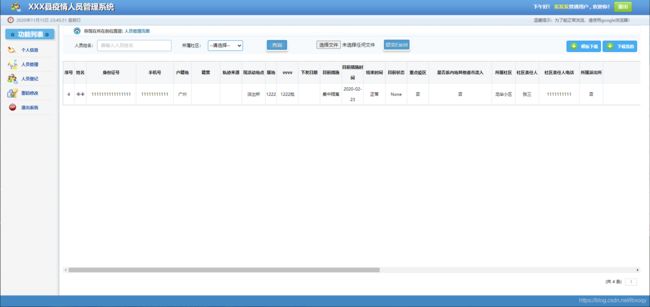基于Python Django的疫情人员管理系统
最近在学习django的drf框架,就拿了一个图书管理系统,历史一个星期,改造成为一个疫情人员管理系统。分为web 和 app端,可以追踪人员的当前情况,加入了图表统计。文末有下载链接
源码下载
文章目录
- 实现过程()
- 相关配置
- Model设计
- 接口设计
- 前端页面
- 运行情况
实现过程()
后端使用Python3.6(django、drf框架)
前端使用html(bootstrap框架)
数据库采用的mysql
相关配置
Django的一些配置,包括解决csrf、数据库、日志配置、静态文件、跨域请求、Json web token认证这些就不具体描述了,先放配置,大部分在网上都可以搜索到,等有空再统一补充一下有坑的地方。
Web端采用django的session进行认证
App端采用json web token 进行认证
Model设计
根据实际生活,设计了以下几张表
用户表
class MyUser(models.Model): # 用户表
roles = (('manager', "管理员"), ('staff', "普通用户"))
account = models.CharField(max_length=20, unique=True, help_text='账户,为手机号') # 账号
password = models.CharField(max_length=20, help_text='用户密码') # 用户密码,明文保存一份,用于web登陆认证
name = models.CharField(max_length=20, null=True, help_text='用户姓名')
identification_card = models.CharField(max_length=18, null=True, unique=True, help_text='用户身份证') # 用户身份证
xianshi = models.CharField(max_length=20, null=True, help_text='所属县市') # 所属县市
community = models.ForeignKey(Community, null=True, on_delete=models.CASCADE) # 所属社区
auth_user = models.OneToOneField(auth_user, null=True, on_delete=models.CASCADE, related_name='auth_user')
role = models.CharField(max_length=20, choices=roles, default='staff', help_text='角色')
enter = models.CharField(max_length=20, null=True, help_text='录入人')
社区表
class Community(models.Model): # 社区表
name = models.CharField(max_length=200, unique=True) # 社区名称
address = models.CharField(max_length=200, null=True) # 主键
人员登记表
class PersonRegister(models.Model): # 人员登记表
is_or_not = (('是', '是'), ('否', '否'))
order = models.CharField(max_length=18, null=True, help_text='序号')
name = models.CharField(max_length=200, null=True, help_text='姓名') # 姓名
identification_card = models.CharField(max_length=18, unique=True, help_text='身份证号码') # 身份证号码
phone = models.CharField(max_length=100, help_text='手机号') # 手机号
census_register = models.CharField(max_length=200, null=True, help_text='户籍地') # 户籍地
native_place = models.CharField(max_length=200, null=True, help_text='籍贯') # 籍贯
track_source = models.CharField(max_length=200, null=True, help_text='轨迹来源') # 轨迹来源
current_activity_location = models.TextField(null=True, help_text='当前活动地点') # 当前活动地点
dependency = models.CharField(max_length=200, null=True, help_text='属地') # 属地
measure = models.CharField(max_length=100, help_text='目前措施') # 目前措施 正常 居家隔离 集中隔离
measure_start_time = models.CharField(max_length=100, help_text='目前措施时间') # 目前措施时间
measure_end_time = models.CharField(null=True, max_length=100, help_text='措施结束时间') # 措施结束时间
current_state = models.CharField(null=True, max_length=100, help_text='当前状态') # 当前状态
epidemic_area = models.CharField(null=True, max_length=100, help_text='重点疫区')
from_other_area = models.CharField(null=True, choices=is_or_not, default='否', max_length=10,
help_text='是否来自其他省份') # 是否来自其他省份
community = models.ForeignKey(Community, null=True, related_name='person_register',
on_delete=models.CASCADE, help_text='所属社区') # 所属社区
community_leader = models.CharField(null=True, max_length=100, help_text='社区责任人') # 社区责任人
community_leader_phone = models.CharField(null=True, max_length=100, help_text='社区责任人电话') # 社区责任人电话
police_station = models.CharField(max_length=100, help_text='所属派出所') # 所属派出所
enter = models.ForeignKey(MyUser, null=True, on_delete=models.CASCADE, help_text='录入人') # 录入人
comments = models.TextField(null=True, help_text='备注') # 备注
isolation_points = models.TextField(null=True, help_text='隔离点') # 隔离点
nucleic_acid_test = models.CharField(choices=is_or_not, default='否', max_length=10, help_text='是否核酸检测') # 是否核酸检测
town = models.CharField(null=True, max_length=100, help_text='乡镇') # 乡镇
has_serious_disease = models.CharField(choices=is_or_not, default='否', max_length=10,
help_text='是否存在重大疾病') # 是否存在重大疾病
special_situation = models.TextField(null=True, help_text='特殊情况')
create_time = models.DateTimeField(null=True, auto_now_add=True, help_text="创建时间")
update_time = models.DateTimeField(null=True, auto_now=True, help_text="最后更新时间")
个人证件记录表
class PersonImage(models.Model):
"""
图片
"""
person_register = models.ForeignKey(PersonRegister, null=True, related_name='poerson_img', on_delete=models.CASCADE)
person_image = models.TextField(null=True, help_text='个人图片信息,base64')
接口设计
接口太多,不一一分享,具体可以查看源码,下面是web的登录接口,app的接口直接使用jwt的认证过程了。
def login_judge(request): # 登入判定
account = request.POST.get("telephone") # 获取前端输入的账户(手机号)
user_password = request.POST.get("password")
result1 = MyUser.objects.filter(account=account) # 在user表里检索是否存在该账户
if len(result1) == 1: # 判断后台是否存在该用户,有则进一步判断密码是否正确
password = result1[0].password # 获取后台的密码
identity = role_desc.get(result1[0].role, '') # 获取该账户的身份信息
request.session['global_sname_xianshi'] = result1[0].xianshi
request.session['global_sname_shequ'] = result1[0].community.name if result1[0].community else ''
request.session['identity'] = identity
if user_password == password: # 将用户输入的密码和后台密码进行比对,如何正确,判断该账户身份
request.session['account'] = account
user = MyUser.objects.get(account=account)
request.session['global_sname'] = user.name
request.session['global_mname'] = user.name
context = {
"name": user.name,
"id": user.identification_card,
"community": user.community.name,
"telephone": account,
"enter": user.enter if user.enter else '',
"identity": identity,
}
return render(request, 'manager/manager_information.html', context) # 跳转到管理员主页界面
else: # 如果不一致则返回相应提示语句
context = {
"info": "密码错误!!!",
"status": 2
}
return render(request, 'login.html', context=context) # 密码错误回到登入界面
else: # 如果不存在该用户则返回相应的提示语句
context = {
"info": "该账户不存在!!!",
"status": 3
}
return render(request, 'login.html', context=context) # 账户不存在则继续回到登入界面
前端页面
登录页,其他页面可查看源码
DOCTYPE html>
<html>
<head>
<title>欢迎来到人员登录界面title>
<meta name="viewport" content="width=device-width, initial-scale=1" />
<meta http-equiv="Content-Type" content="text/html; charset=utf-8" />
<meta name="keywords" content="" />
<script type="application/x-javascript"> addEventListener("load", function() {
setTimeout(hideURLbar, 0); }, false); function hideURLbar(){
window.scrollTo(0,1); } script>
<link href="../static/css/style1.css" type="text/css" rel="stylesheet" media="all">
<link href="../static/css/jquerysctipttop.css" rel="stylesheet" type="text/css">
<style>
.p_one{
color: #4fff24;
position: relative;
left: 636px;
top: 69px;
font-size: 23px;
font-family: monospace;
}
style>
head>
<body>
<section>
<div class="stage">
<h1>欢迎来到XXX疫情人员管理系统h1>
<div class="cbImage active signin agileits">
<h3>登录h3>
<form action="/login_judge/" method="post">
{% csrf_token %}
<input type="text" name="telephone" class="name" placeholder="手机号" required>
<input type="password" name="password" class="password" placeholder="密码" required>
<input type="submit" value="登录" style="position: relative;top: 47px;left: 11px;">
form>
div>
<div class="clear">div>
div>
section>
<script src="../static/js/jquery-2.1.4.min.js">script>
<script src="../static/js/coverflow-slideshow.js">script>
body>
html>




